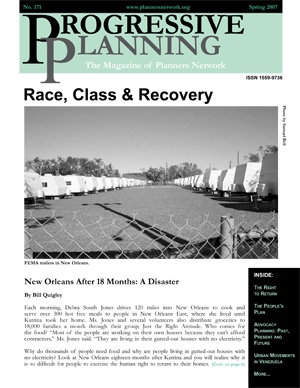By Elizabeth Yeampierre
It is not true that if the major environmental organizations had addressed the justice issue there would not be an environmental justice movement. Environmental justice not only speaks to the disparate impact of environmental burdens in our communities, but also to the need to develop indigenous leadership. Environmental justice grew out of the civil rights movement and is built on the premise that communities of color can speak for themselves. The fact that we speak for ourselves continues to be the biggest challenge for those who have social justice sensitivities and want to work in our communities—and often speak for us. As planners, addressing this challenge requires a certain amount of humility. It requires at times taking a back seat to people who don’t look like you or who lack formal training, but who do have a community vision. Environmental organizations are now hiring staff to work on environmental justice issues and in doing so they are not only supplanting local indigenous leadership, they are also taking a good portion of the limited financial resources available to do this work. The enviros should really be focusing on providing technical assistance at the request of local groups. As the demographics in New York City continue to change, it is more important than ever that community members are stakeholders in decision-making processes. Not only do our communities know what the issues and problems are, they often know the solutions. Principled collaborations are important if we are going to move forward in a just way.
Environmental justice has become extremely sexy. Everyone wants to do it and nobody even considers whether it is appropriate to apply for a position that was created out of the civil rights struggle so people of color could step up to leadership. Sometimes people apply for these positions because they are simply motivated by the desire to offer their skills to a community in need. A commitment to justice means that the role you take may be different than what you anticipate. You may need to, despite your good intentions, put your privilege in check and say, “You know what, maybe this position should go to a person of color, or maybe there is another role I can play to lend support.” The environmental justice movement is about leveling the playing field, which sometimes requires giving something up.
I sit on Mayor Bloomberg’s Sustainability Advisory Board in New York City. When the deputy mayor talked about reducing carbon emissions in the city, I was concerned about carbon spikes. I felt that before we even think about reducing carbon emissions, we first have to look at our most vulnerable communities—those that have the bulk of the power plants, transfer stations, solid waste facilities and highways, as well as high asthma levels and population densities—and start reducing carbon levels there first because that is consistent with civil rights and affirmative action. When we reduce carbon emissions in NYC’s most environmentally burdened communities, the entire city benefits.
Diversity
Diversity has become such a broad catch phrase that basically anybody from anywhere who does not have a history of discrimination in this country can come in and take positions that were created to address the effects of past discrimination. But the truth is that the number of blacks in colleges, law schools and graduate schools has gone down. We have to be intentional if we really believe in justice. We have to look at our institutions and ask how we can incorporate people of color. My organization is a multi-racial, multi-national, multi-ethnic, intergenerational organization. You have to be intentional about it.
Sophistication
In our organizations and our movement in New York City, we have become experts on energy. We stopped power plants from coming into our communities. We passed the first brownfields legislation in the state. We passed the Solid Waste Management Plan. These were all grassroots initiatives that ended up setting citywide policy for the people of New York City. They illustrate how sophisticated the environmental justice movement has become. So what about the role of planners? Planners need to redefine their roles because they are important and we need you there. We need to have a movement that incorporates everyone and the best thinking of all involved.
Gentrification
Our environmental justice successes have turned into gentrification opportunities in our communities. With every greenway, green roof and urban forestry initiative that we plan, our communities are being displaced. Developers even use our successes in their promotional literature. What our communities are being told is that unless we live next to a waste transfer station or a power plant, we don’t deserve to live there and our young people don’t deserve to breathe clean air or have open space. So that is the next struggle for the environmental justice movement: to make sure that all of these environmental amenities that we have been fighting for don’t end up displacing our people.
